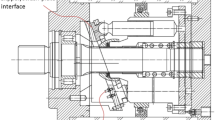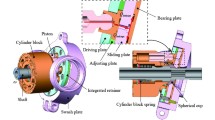Abstract
Improving the carrying ability of oil film between slipper and swash plate and reducing the partial abrasion of slipper are important to improve the service life and reliability of axial piston pump. In this paper, a numerical simulation model was developed for slipper/swash-plate friction pair based on the elastohydrodynamic theory. The dynamic micro-motion and pressure distribution of slipper were analyzed and it was pointed out that the tilt of slipper was the main reason for its partial abrasion. The simulations about the slippers with different slopes on the outer edge of the sealing belt showed that the partial abrasion could reduce the carrying ability and increase the leakage of the slipper/swash-plate pair. The proper slope on the inner edge helped to improve the carrying ability and reduce the leakage of slipper. The experimental tests were in accord with the simulation results to a great extent, showing that the simulation model had a high accuracy and could be applied to the design and optimization of slipper, and that the slipper with optimal inner slope provided an encouraging method to improve the efficiency and reliability of axial piston pump.
Similar content being viewed by others
References
Wieczorek U, Ivantysynova M. Computer aided optimization of bearing and sealing gaps in hydrostatic machines-the simulation tool CASPAR. Int J Fluid, 2000, 3(1): 7–20
Manring N, Wray C, Dong Z. Experimental studies on the performance of slipper bearings within axial piston pumps. J Tribol-T ASME, 2004, 126(7): 511–518
Choudhuri K, Maiti R. Experimental investigation on swash plate-piston slipper lubrication in hydrostatic units. In: Proceedings of the 1st FPNI-PhD symposium on fluid power. Hamburg: Technical University of Hamburg-Harburg, 2000. 485–492
Koc E, Hooke C, Li K. Slipper balance in axial piston pumps and motors. J Tribol-T ASME, 1992, 114(10): 766–772
Koc E, Hooke C. Investigation into the effects of orifice size, offset and overclamp ratio on the lubrication of slipper bearings. Tribol Int, 1996, 29(4): 299–305
Harris R, Edge K, Tilley D. Predicting the behavior of slipper pads in swashplate-type axial piston pump. ASME J Dyn Syst Meas Control, 1996, 118(3): 41–47
Huang C C. CASPAR based slipper performance prediction in axial piston pumps. In: Proceeding of the 3rd FPNI-PhD symposium on fluid power. Spain: E. Codina, 2004. 229–238
Ivantysyn J, Ivantysynova M. Hydrostatic Pumps and Motors. Inadia: Akademia Books International, 2001. 136–139
Ma J E. Study on the mechanism of fluid-born noise generation in axial piston pump (in Chinese). PhD Dissertation. Hangzhou: Zhejiang University, 2009. 42–43
Xu Y M. Oil Film Theory and Friction Pair Design of Hydraulic Pump and Motor (in Chinese). Beijing: China Machine Press, 1987. 104–105
Author information
Authors and Affiliations
Corresponding author
Rights and permissions
About this article
Cite this article
Xu, B., Zhang, J. & Yang, H. Investigation on structural optimization of anti-overturning slipper of axial piston pump. Sci. China Technol. Sci. 55, 3010–3018 (2012). https://doi.org/10.1007/s11431-012-4955-x
Received:
Accepted:
Published:
Issue Date:
DOI: https://doi.org/10.1007/s11431-012-4955-x




